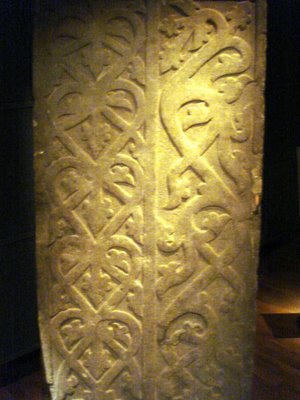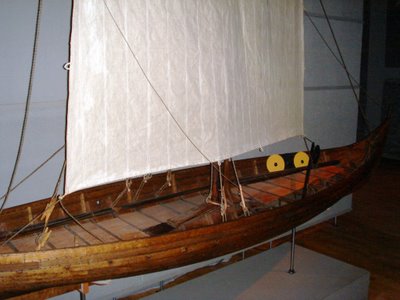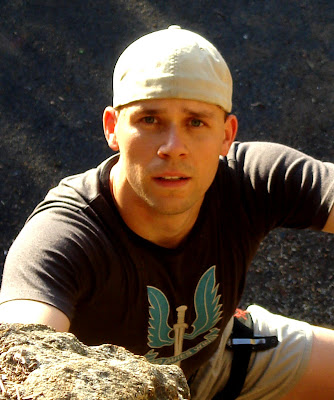04 Orða þeira er maðr öðrum segir opt hann gjöld um getr
 I've also been to see the Viking exhibit at the Historiska museet in Östermalm and have taken some pics. I learned some interesting facts and information, and have since done some further research that I'd like to share with you now. For instance, did you know that the Vikings never wore those horned helmets that they are so often depicted as wearing?
I've also been to see the Viking exhibit at the Historiska museet in Östermalm and have taken some pics. I learned some interesting facts and information, and have since done some further research that I'd like to share with you now. For instance, did you know that the Vikings never wore those horned helmets that they are so often depicted as wearing?
Speaking of combat, the word berserk actually comes from the Old Norse word berserkr meaning "bear skin" or "bare skin" alluding either to wearing the "skin" of a bear (either literally or to be bear-like in rage and strength) or to the habit of berserkers going into battle unarmoured, or often completely naked!
Berserkers fought with crazed strength, heedless of danger. They worked themselves up into a bloodlust – berserker rage – before battles, performing ritualistic group chants and dances, banging their helmets with their weapons, biting their shields, and howling. They were said to be immune to pain (or even immune to weapons) in battle.
Yes! There is proof the Vikings actually discovered North America some 500 years before Christopher Columbus. They called it "Vinland the Good" and settled briefly at a place known today as L'Anse aux Meadows, Newfoundland, Canada. The map below shows just a few of the major voyages of discovery some prominent Vikings undertook.

The role of women in Viking society is rather interesting. A woman did not fully become part of her husband's family when she married. She continued to be a part of her own family and everything she brought into the marriage remained her personal property and did not fully become part of her husband's estate. The bride brought linen and wool, a spinning wheel, a loom and a bed as part of her dowry. Women from richer families could also have jewellery of silver and gold, farm animals and even farms as a part of their dowry. Her children would in turn inherit this property as part of their maternal inheritance.
If her husband mistreated her and the children, or he was too lazy to be a good provider or insulted her family, she could divorce him. The procedure was simple. She had to stand at the door of her home and declare herself divorced, name the reason for the divorce and name three witnesses (which obviously had to be there too). She also had to repeat this procedure next to the marriage bed.
Babies and toddlers automatically stayed with their mother after a divorce. The bigger children were divided between the parents according to the wealth and status of the two families. Under the law, she was entitled to receive her dowry back in whole as well as half of what her husband had earned during the marriage. With her right to property, inheritance and divorce the Viking woman had more legal rights than most women elsewhere in Europe at the time. Children were also protected by law as members of the family, and their rights to inheritance even after a divorce. More info on the importance of women in Viking society can be found here.
Viking society valued its belief in eternal kinship and ethics. Honesty, loyalty and fairness were the predominant ideas of the culture. When these were broken, the society would begin to fail. Therefore, punishment could be severe. Although the Vikings are known for their ruthless battle tactics, at home they were a loving, fair people with a strong sense of family pride, loyalty and ethics. In many ways, they were ahead of their time.
The language the Vikings spoke was Old Norse which is most closely comparable to Icelandic today, but is also the language that gradually evolved into modern Faroese, Norwegian, Danish and Swedish. This brings us to the title for this post:
The written language of the Vikings is called runes (runic alphabet) but was rarely used as most information was passed on verbally. An image and example of the first two rune words from the Sigurd inscription on the Rasmundsberget rune stone from Jäder in Södermanland, Sweden is provided below:
These two first words translate to the letters sirithr:kiarthi (in Old Norse sounds) which in English means sigrid:made. The entire text from this particluar rune stone translates to this:
Which in English is:
sigrid.made.bridge.this.mother.alriks.daughter.Orms.for.soul.holmgers.father.sigroeds.husband.her
Which makes a bit more sense in English written as:
Sigrid, Alriks mother, Orms daughter made this bridge for her husband, Holmgers, father of Sigoerd, soul.

 Implements of Death (dödens redskap)
Implements of Death (dödens redskap)(they actually called them that at the museum!)
Common weapons were the spear and axe.
Swords were of higher status and could even acquire personal names.
 Unna's runsten (rune stone)
Unna's runsten (rune stone) Runsten from Resmo, Öland island
Runsten from Resmo, Öland island Grave orbs (gravklot)
Grave orbs (gravklot) Reconstructed clothing (rekonstruerade dräkter)
Reconstructed clothing (rekonstruerade dräkter)The Vikings also used soap, long before it was reintroduced to Europe and washed once a week on laugardagr (Old Norse meaning "the day of the washing") which we know today as Saturday. They especially washed their hair, in a special solution made out of lye of ashes (askelut) which made the hair yellowish or reddish. Laug means washingwater, and comes from 'lut' in 'askelut'. To this day, Saturday is referred to as lördag "bathing day" in the Swedish language and the relevant equivalent in the other Scandinavian languages.
 Sven made me (Sven gjorde mig)
Sven made me (Sven gjorde mig)Atli had learned of the treasure of Sigurd that should have belonged to Gudrun at his death. Atli wanted to gain possession of Sigurd's cursed treasure from Gunnar. Atli invited Gunnar to come to a feast in Hunland. Unlike the German tradition, Gudrun was more loyal to her brothers than her second husband Atli. Gudrun did not seek to avenge Sigurd upon her brothers.
Gudrun immediately discovered her husband's intention and tried to warn her brothers of the betrayal. When Atli sent a message to lure his brother-in-laws to Hunland, Gudrun carved runes into her message and also wrapped wolf's hair on the cursed ring Andvaranaut. But the message was distorted by Atli's messenger Vingi who could read runes. So Vingi changed the runes so that it urged Gunnar and Hogni to come to visit her.
Vingi came to Gunnar's court, inviting the brothers to visit their sister and her husband. They received gold from Atli, and Vingi told Gunnar that there would be more gold if he and Hogni would visit their sister. Gunnar and Hogni were suspicious of Atli's generosity. Both Gunnar and Hogni were puzzled by the wolf hair on Gudrun's ring (Andvaranaut), despite the altered message on the ring. The wolf hair must signify danger, so that Gudrun was advising her brothers not visit Atli.
Gunnar's new wife named Glaumvor also warned the king not to go. Gunnar and Hogni however decided to go, but before leaving they sank Sigurd's treasure in the Rhine and each of them swore an oath never to reveal the location of Sigurd's treasure, which now became known as Rhinegold. The Giukings (Burgundians) with their followers, then set out for Atli's court.
When they arrived Atli immeditately demanded the treasure of Sigurd. Gunnar flatly refused, so Atli had the guests ambushed. A fierce battle broke out and though the Burgundians proved to be great warriors, they were helplessly outnumbered.
Gudrun seeing her brothers' plight, went to them and greeted both her brothers with kisses before asking if it was possible for them to have peace with her husband. They said peace was not possible so she donned a mail coat, took up a sword and joined the Burgundians and fought as bravely as her brothers. However her aid wasn't enough to save her brothers. Eventually, all the Burgundian warriors were killed in the fighting, except Gunnar and Hogni who bravely fought on until Atli's warriors managed to capture them alive.
Neither brother would reveal the location of the treasure. When threatened with torture, Gunnar told Atli he would reveal the location on the condition that the king cut out his brother's heart. Gunnar told the king he did not want his brother learning of his betrayal.
Atli had the heart of the thrall named Hjalli cut out and brought to Gunnar, pretending this was the heart of Hogni. Gunnar took one look at the heart and was not deceived by Atli's trickery. Gunnar told the king that this was the heart of the coward Hjalli, because it quaked tremendously. So Atli had Hogni murdered and cut out his heart. Gunnar then knew his brother was dead because Hogni's heart does not tremble in his hand, because Hogni was brave.
Then Gunnar laughed at Atli telling the treacherous king that he would never tell him the secret of treasure's location. For while Hogni was alive Gunnar wavered, but now that his brother was dead he is the only person who could reveal its location. Gudrun came to her husband (Atli) and cursed him for betraying her and her brothers.
Realising that Gunnar would not reveal the whereabouts of the treasure, the enraged king ordered Gunnar to be thrown into a pit full of adders. Gudrun learning of her brother's fate, threw a harp to Gunnar. Since his hands were tied tightly to his body, Gunnar played the harp with his toes so well that all but one adder fell to sleep by his sweet music. But that one adder was enough to kill him.
Atli boasted over the death of Gudrun's brothers, but tried to reconcile with his wife with gift of gold. Gudrun was satified to live with Atli as his wife while Hogni had lived. With Hogni's death, Gudrun sought to avenge her brothers.
Gudrun had a huge funeral feast prepared in honour of her brothers and those of Atli's kins who had died. While Atli and his guests became intoxicated with wine, Gudrun went into her sons' room. Gudrun, who could not rest after the death of her brothers, cut the throats of her two sons Erp and Eitil; her sons that she bore to Atli. Gudrun mixed their blood with the wine and roasted their hearts in the spits before serving them to the drunken king and his guests.
When Atli asked his wife where their sons were (rather sweetly) Gudrun told him he had eaten their flesh. Gudrun then took up a sword and stabbed Atli to death. Gudrun bitterly told her dying husband that she still loved Sigurd, and though she could live with being a widow to Sigurd, she could not bear it with her being married to him (Atli).
With the help of her nephew Niflung son of Hogni, they set the entire hall on fire, killing her husband's drunken guests.
 Christian text, heathen pictures (Kristen text, hedniska bilder)
Christian text, heathen pictures (Kristen text, hedniska bilder)På Svenska:
Söner Liknats (lät göra) märke gott efter Ailika, hustru god, moder (Gud och Guds moder nåde) henne och dem som gjorde märket (det största som) män månde se.
In English:
Sons of Liknats (had) made memorial made in honour of Ailika, good wife, mother (may God and God's mother give grace) to her and those who made the memorial (the largest which) might be seen.
 Lilies on the grave (liljor på graven)
Lilies on the grave (liljor på graven)
 Agile boats and ships (de smidiga skeppen)
Agile boats and ships (de smidiga skeppen)The longship's long narrow hull and shallow draft allowed navigation in waters only one metre deep, and permitted rapid beach landings. Its light weight allowed it to be carried over land. Longships were also symmetrical, allowing the ship to reverse direction quickly. They were fitted with oars along almost the entire length of the boat. Later versions sported a rectangular sail on a single mast which was used to augment the efforts of rowers, particularly during long journeys. In combat, the variability of wind power made rowers the primary means of propulsion. A Viking ship's steering oar or styribord, was mounted on the right-hand side hence the modern nautical term "starboard."
 Nazi misuse of history
Nazi misuse of historyA German soldier stands in a Viking ship - yeh right...

Your Viking Personality: You're a doughty, stalwart Viking. You have a thirst for battle, and tend to strike first and think later. As a Viking, you're one of the "berserkers", and rush into battle with no clothes on. If the sight of you naked isn't enough to disable the enemy, your sword certainly will be.
You can handle long sea voyages easily, despite the lack of amenities. Other Vikings consider you "one of the guys".
You have a fairly pragmatic attitude towards life, and tend not to expend effort in areas where it would be wasted. You sometimes come off as a bit of a snob. Vikings are not snobbish people -- they either like you, or they kill you. Try to be more like a Viking.
That's it for now! Hope you've enjoyed the ride. Blog again soon!Ek biðr þá nú vel fara!
(That's I bid you farewell in Old Norse)
Ty









0 Comments:
Skicka en kommentar
<< Home